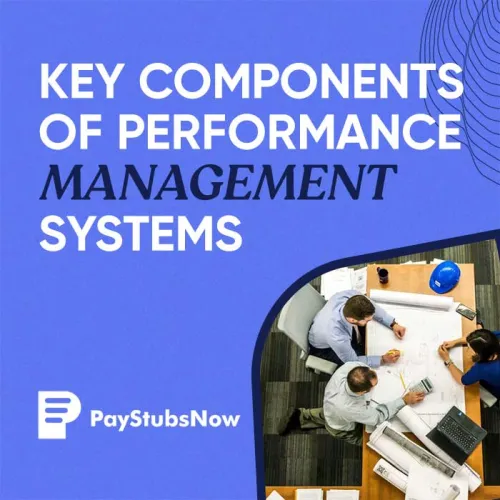


Performance management is a broad term that encompasses the performance management process, performance management cycle, and performance management systems organizations use to drive employee performance and business success.
A well-designed performance management system includes performance management components such as goal setting, feedback, coaching, and employee development plans, which are essential for the entire process.
Organizations deploy performance management systems to ensure that employees meet the organization's standards and objectives, fostering company's goals and ensuring team outcomes.
The goal of effective performance management process is to improve employee productivity , motivation, and drive high performance. A well-designed system will help identify problems and potential areas for improvement before they become serious issues.
In this article, we’ll cover the key components of performance management systems and discuss the benefits of using such a system in your business.

The performance management components of an effective system include goal setting, measuring results, providing feedback, and performance appraisal to improve performance and foster employee evaluation.
Performance management systems help businesses drive productivity and business success by tracking employee productivity and achieving company's goal achievement through annual reviews and continuous monitoring.
These systems also provide a mechanism for regular check-ins and valuable insights through feedback on performance, alongside coaching and development opportunities that align with organizational culture.
Performance management systems are essential pillars for organizations to effectively evaluate, monitor, and improve performance, providing additional support and clear expectations for employee motivation.
These systems consist of several key components that work together to create a comprehensive framework for managing and optimizing performance. In this response, we will explore these components in detail, highlighting their significance and role in performance management.
The first step in an effective performance management system is goal setting. Employees should be given specific, measurable goals that are aligned with the company’s strategy.
Goals should undergo regular check-ins and be updated to ensure relevance, setting realistic expectations and providing valuable insights through feedback on progress towards meeting these clear expectations.
By implementing these strategies, businesses ensure that their employees are focused on the most important tasks, contributing to outstanding work and driving the company towards various aspects of organizational success.
Goal setting is a fundamental component of performance management systems. Clear and specific goals provide employees with a sense of direction and purpose, aligning their efforts with the organization's objectives.
These goals should be SMART (Specific, Measurable, Achievable, Relevant, and Time-bound) to ensure they are meaningful and attainable. By setting realistic goals and providing clear expectations, employees gain a clear understanding of what is expected, enabling them to focus their efforts on the soft skills and critical areas that lead to high performance.

In business, effective measurement is key to improving productivity and efficiency. A performance management system can help organizations to measure employee productivity and identify areas in which they may need improvement, providing valuable insights that contribute to organizational culture and business success.
The current performance management system typically consists of a set of tools and processes that allow managers to track, measure, and analyze valuable employee performance data, providing valuable insights into traditional performance management techniques.
By far the most important element of any performance management system is accurate and timely measurement of results.
Without valuable data, it's impossible to identify areas in which employees need improvement or assess the effectiveness of changes in the performance management processes, crucial for continuous improvement and setting realistic goals.
In order to measure results efficiently, a performance management system should include:
-A system for tracking employee productivity
-Tools for measuring employee performance against specific goals or objectives
-Processes for analyzing data and identifying trends
-A system for reporting results to managers and employees
Lastly, it’s important to ensure that employees are properly trained in how to use the system and understand the goals of the organization.
Performance planning involves defining performance expectations, discussing job responsibilities, and setting performance targets with employees. It establishes a mutual understanding between managers and employees regarding performance standards and job requirements.
Performance planning may include performance agreements, job descriptions, and performance improvement plans. These documents provide a framework for evaluating performance and serve as a reference point for ongoing feedback and performance appraisals.

In addition to the employee feedback you provide financially, like when you make your 1099 s at the end of the year, strong performance management systems also include mechanisms for timely, specific, and actionable feedback.
Feedback should be directed at employees’ individual strengths and weaknesses, as well as their overall job performance. Employees need to know how they are doing so that they can improve their work if necessary. However, providing feedback is often difficult for managers.
There are a few key things to keep in mind when giving feedback :
-Be specific. Do not simply say that an employee’s work is “good” or “bad.” Give concrete examples of what they did well and what could be improved.
-Make it actionable. Feedback should always include specific steps that an employee can take to improve their work.
-Be timely. Feedback should be given as soon as possible after the relevant event has occurred. This will help ensure that the feedback is still fresh in employees’ minds.
-Be positive. It is important to give as much positive feedback as negative. This will help employees feel motivated to continue doing their best work.
By following these guidelines, managers can provide employees with quality feedback they need to improve their work.
Regular and ongoing feedback is crucial for employee development and continuous improvement. Performance management systems facilitate a culture of open communication and constructive feedback between managers and employees.
Feedback can be both formal and informal, ranging from scheduled performance discussions to day-to-day coaching and guidance.
Effective feedback focuses on strengths, areas for improvement, and actionable suggestions for growth. It helps employees understand how their performance aligns with expectations and enables them to make necessary adjustments.
Measurement, feedback, and goal setting are all important components of an effective performance management system. They work together to provide a framework for improving employee productivity. However, all of these components hinge on one essential element: correcting performance .
In order for any system to work, employees must be able to identify their mistakes and learn from them. Managers must also be able to provide feedback that is specific, actionable, and timely. This type of feedback is essential for employees who are looking to improve their performance.
In addition, providing employees with clear goals is another important way to help them improve their productivity. Goals should be attainable and relevant to the employee’s job. When employees are able to see how their individual efforts contribute to the organization’s overall objectives, they are more likely to be productive.
By using a performance management system, employers can ensure that their employees are productive and contributing to the organization’s success.
Performance appraisals are formal evaluations conducted periodically to assess an employee's performance against predefined goals and standards. These appraisals provide a comprehensive review of an employee's achievements, skills , competencies, and areas for improvement.
The evaluation may involve self-assessments, peer assessments, or input from stakeholders such as customers or colleagues. Performance appraisals serve as a basis for making decisions related to promotions, rewards, and career development.

Some organizations utilize performance rating scales or numerical scoring systems to quantify performance levels. These ratings provide a standardized way of summarizing and comparing individual performance across the organization.
While ratings can be useful for performance differentiation, they should be used with caution to ensure fairness and accuracy. Rating systems should be well-defined, transparent, and based on objective criteria to maintain credibility and avoid biases.
Performance management systems rely on various metrics and key performance indicators (KPIs) to measure progress towards goals and objectives. These metrics may include productivity, quality, customer satisfaction, sales revenue, or any other relevant measures.
Performance measurement enables organizations to track individual and team performance, identify trends, and make data-driven decisions . It also provides a basis for identifying areas of improvement and establishing benchmarks for future performance evaluations.
Employee development and training are essential aspects of performance management systems. These systems help identify skill gaps and provide opportunities for training, coaching, and career growth .
Personal development plans may be created to outline specific actions and resources required for improvement. By investing in employee development, organizations enhance their talent pool, increase employee engagement, and foster a culture of continuous learning and improvement.
Recognizing and rewarding high-performing employees is a crucial component of performance management. These systems include monetary incentives, promotions, public acknowledgment, or other forms of recognition to motivate and retain top performers.
Rewards and recognition programs should be fair, transparent, and tied to performance outcomes to ensure they are perceived as meaningful and equitable.

In cases where an employee's performance falls below expectations, performance management systems help identify areas for improvement and develop action plans to address shortcomings.
Performance improvement plans outline specific steps, timelines, and support mechanisms to help employees meet performance standards. These plans involve close monitoring, ongoing feedback, and additional training or resources as necessary.
Documentation and record-keeping play a critical role in performance management systems. Accurate and detailed records of performance-related discussions, feedback, and appraisal outcomes support decision-making, facilitate legal compliance, and provide a historical record of an employee's performance trajectory.
These records help identify patterns, track progress, and serve as a basis for future performance evaluations.In conclusion, performance management systems consist of several interconnected components that together form a comprehensive framework for managing employee performance.
From goal setting and performance planning to ongoing feedback, performance appraisals, and rewards and recognition, each component contributes to creating a culture of performance excellence, aligning individual efforts with organizational goals, and fostering continuous improvement within the workforce.
Performance management is a critical part of any business. By establishing and monitoring key performance indicators, you can ensure that your team is working efficiently and effectively towards your organization’s goals. A well-run performance management system can help to improve productivity, morale and overall employee engagement.